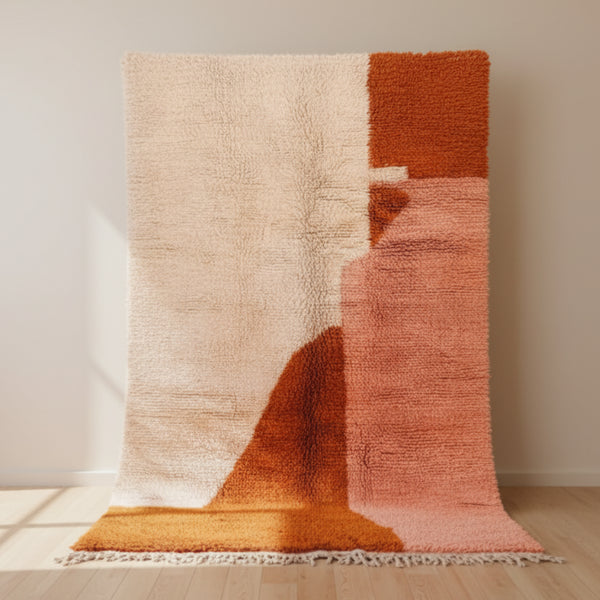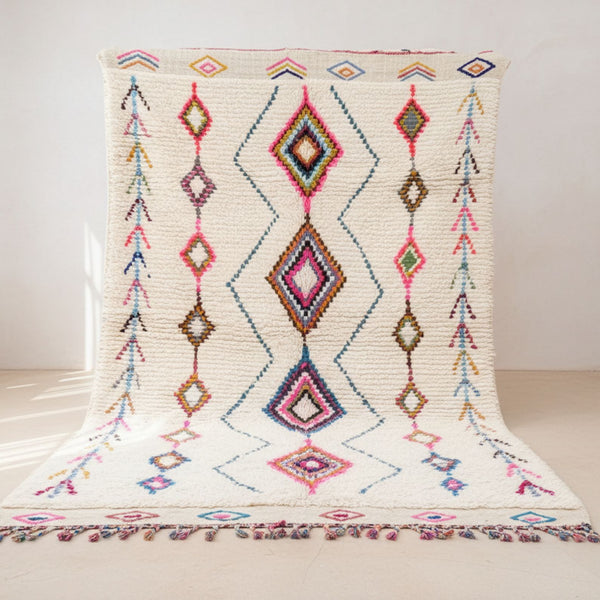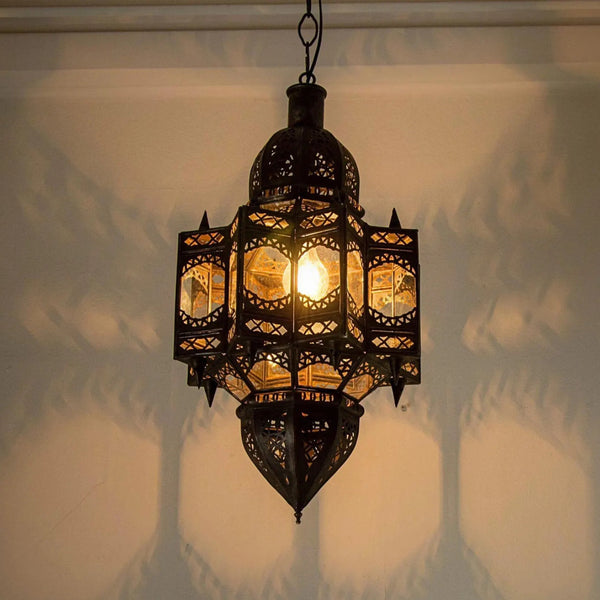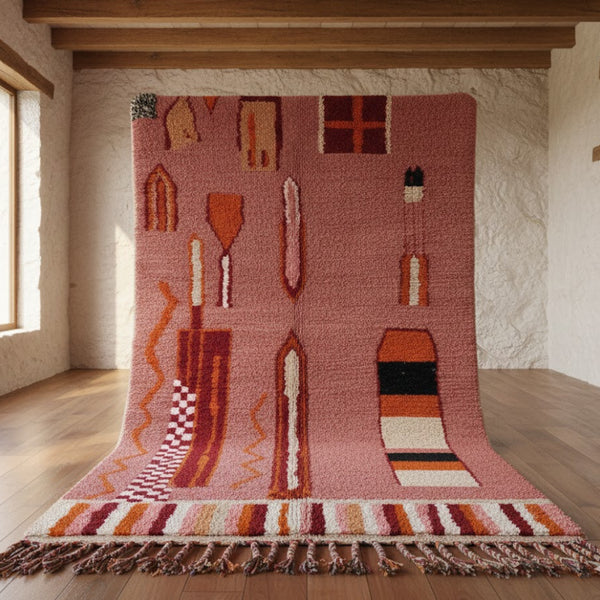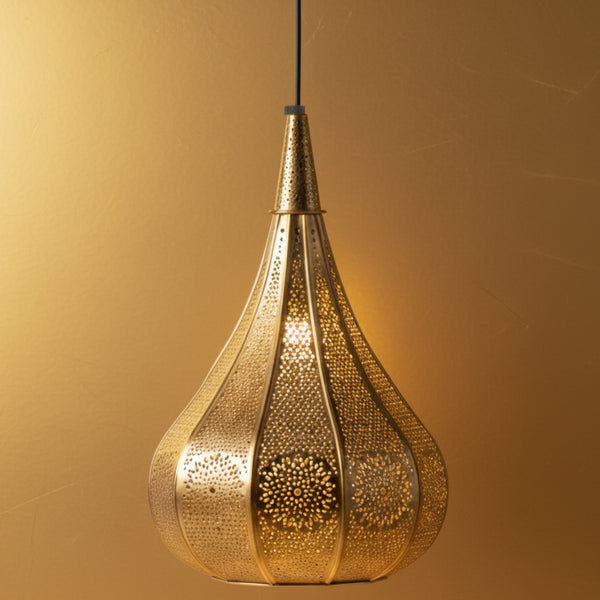What to Consider Before Buying Brass Moroccan Lamps
Posted by AADIL KHAN
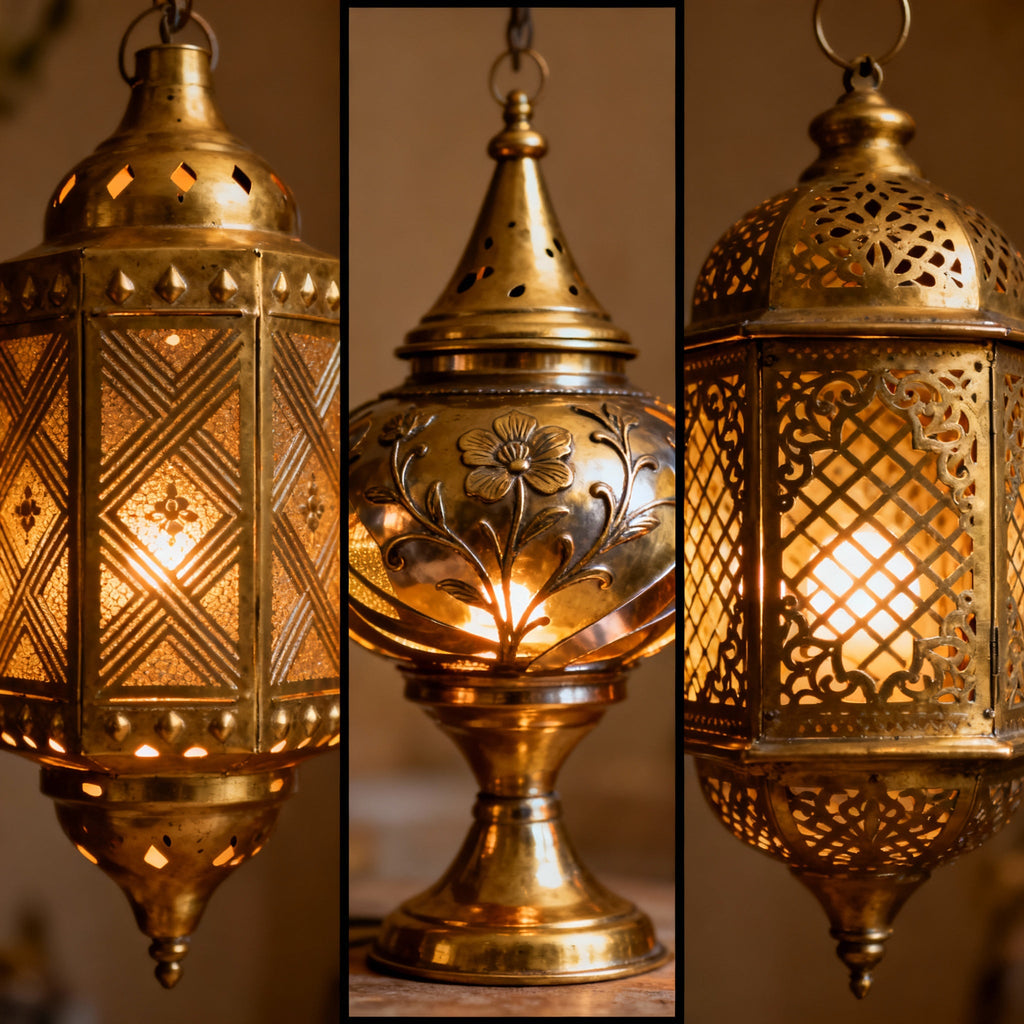
Buying good lighting can completely change a room, so it's important to think carefully about the decision instead of just buying it on a whim. Brass Moroccan lamps are big investments that make a statement about your style for a long time. Making smart choices will keep you happy with your purchase for decades. This complete guide gives you all the information you need to choose fixtures that fit your space, budget, and style perfectly. It covers everything from authenticity to sizing to functionality to quality.
How to Tell the Difference Between Real Brass Moroccan Lamps and Fake Ones
Distinguishing genuine brass Moroccan lamps from mass-produced imitations requires understanding specific authenticity markers that separate handcrafted treasures from manufactured alternatives. The solid brass construction makes the pieces very heavy for their size. Plated or hollow imitations don't have this density. If you can, lift the fixtures. The weight of real brass shows right away that it is good quality.
Hand-pierced holes show small differences that show they were made by an artisan. Look closely at the hole patterns. If the spacing and size are exactly the same, the holes were made by a machine. If the spacing and size are slightly different, the holes were made by hand. These "imperfections" show that the item is real, not a flaw, and they give it a character that mass production can't copy.
Traditional geometric patterns use design languages that are unique to Moroccan metalworking traditions. Look for real patterns to tell the difference between culturally accurate designs and generic decorative motifs that are used without understanding the culture. Reputable sellers give information about the item's history, such as the name of the maker or the artisan cooperative, which makes their claims of authenticity more believable.
Price checks keep people from being disappointed. Real handcrafted brass Moroccan lamps cost more because of the materials and skilled labor that go into making them. Prices that are too low are almost always a sign of imitations or poor quality. It's important to look for value, but if you expect handmade prices to be the same as those of mass-produced goods, you'll always buy bad products, no matter what the ads say.
Things to think about when sizing your space
Correct sizing determines whether fixtures improve or clutter spaces, so it's important to do the math right before buying. Use the basic formula: add the length and width of your room in feet. The result will tell you the right size of fixture in inches. To get the right proportions in a 14x16-foot room (14+16=30), you need fixtures that are about 30 inches in diameter.
The height of the ceiling has a big effect on how big the fixture looks, so adjustments need to be made beyond basic formulas. If you have 8-foot ceilings, the calculated dimensions will work, but if you have taller ceilings, you'll need to make the sizes bigger to keep the visual presence. For every foot above eight feet, add three inches to the fixture's diameter. For example, nine-foot ceilings add three inches, and ten-foot ceilings add six inches to your calculated baseline.
The size of a room depends on more than just math. Rooms with a lot of furniture need fixtures that are a little bigger to stand out in a crowded space, while rooms with little furniture can use fixtures that are more conservative in size without looking too small. Look at the overall visual weight, not just the floor space.
It's important to measure the height of the ceiling at the installation site because older homes often have different heights in different rooms. Take note of any ceiling features, like beams or coffers, that could get in the way. Before you go shopping, write down the dimensions of the space. Make sure that the fixtures have at least 7 feet of floor clearance and aren't too far from the ceiling, which would lessen their impact.
Picking Moroccan Pendant Lights Over Other Styles

Moroccan pendant lights work better in some situations than others, so choosing the right style is very important for making them work. Pendants are better than dining tables and kitchen islands because they can be hung at different heights to create cozy lighting zones without taking up space at eye level. Their hanging nature draws the eyes up and lights up the surfaces below very well.
The main functional benefit of pendants is that they can be adjusted in height. Most have adjustable chains or cords that let you set the exact height you need to hang them. This flexibility works with different ceiling heights and table sizes that fixed-mount options can't handle. Check the adjustment options before you buy, since some cheap pendants don't let you change the height or only let you change it a little.
If you have low ceilings (less than 8 feet), narrow hallways, or small spaces where pendants can hit your head or make things look crowded, think about flush or semi-flush Moroccan ceiling options. These styles add decorative Moroccan metalwork character while keeping the necessary clearances in hard-to-reach places. They also work well in places where pendants don't provide enough ambient light.
The best style choice depends on where the installation will be. Moroccan pendant lights work best when they are in the middle of a room over a specific area, like a table, an island, or a conversation area, where their focused downward light serves a purpose. Multi-pendant arrangements are good at lighting up long surfaces. For general room lighting that doesn't focus on a specific task, ceiling-mounted options spread light more evenly throughout the room.
Brass Finish Choices: Polished, Aged, or Old
Choosing a finish affects both how it looks right away and how much maintenance it will need in the long run, so this choice is important for lifestyle compatibility. Polished brass has a beautiful golden shine that catches and reflects light in a way that makes it look modern and glamorous. It's great for modern or transitional spaces. This finish does, however, need regular care because natural oxidation dulls the shine, so it needs to be polished every so often to keep its original look.
Aged or antiqued finishes give a controlled patina that gives a piece a vintage look without needing to be maintained all the time. These treatments use darkened oxidation in a smart way to give the brass depth and dimension while also protecting it from further natural tarnishing. This choice is great for people who want a traditional look without having to polish it. It works well in bohemian, eclectic, or vintage-inspired spaces.
Over time, natural brass without protective coatings develops an organic patina that gets darker as it is exposed to the elements. This living finish gives fixtures real character as they get older. Areas that get a lot of use stay brighter, while details that are recessed get darker. If you like how materials age naturally, accept this change, but know that the way they look will change a lot over time.
When choosing finishes, think about the metal elements that are already there. Mixing metals works great in modern design, but to avoid jarring clashes, the temperature should stay the same—either all warm or mixed in a planned way. Brass that has been polished goes well with chrome or nickel on purpose, while brass that has been aged goes well with oil-rubbed bronze or copper accents.
How Bright the Light Is and Which Bulbs Work
Perforated Moroccan designs make ambient lighting instead of bright task lighting, so it's important to have realistic output expectations. Compared to open fixtures, the pierced patterns scatter and cut down on light transmission, creating soft, shadow-casting light that is great for creating an atmosphere but not enough for work areas. Plan extra lighting for kitchens, offices, or any other place that needs bright, focused light.
Check to see if the bulbs you want to buy will fit in the fixtures you want to buy them for, since some fixtures only work with certain types of bulbs. Brass handles heat well, but many fixtures now say they need to work with LED bulbs to save energy. Check the maximum wattage limits to make sure that bulbs can't be installed that are higher than the fixture's ratings. This could damage the fixtures and make them unsafe.
LED technology has many benefits for Moroccan fixtures, such as producing less heat, lasting longer so that bulbs don't have to be changed as often in hard-to-reach places, and saving energy that makes up for the higher cost of bulbs. Make sure the color temperature of the LEDs matches the mood you want to create. For example, warm white (2700–3000K) looks like traditional lighting, while cooler temperatures make decorative fixtures look more like institutions.
Dimmer compatibility makes lighting more flexible by letting you change it from bright task lighting to a soft ambient glow. Check that both the fixture and the bulbs you chose work with dimmer switches, since not all combinations work well together. Dimmable LED bulbs made just for this purpose stop flickering and humming problems that happen with incompatible pairs.
Requirements for installation and compatibility with ceilings

The ratings of electrical boxes must be able to support the weight of the fixtures, since brass fixtures are much heavier than other types. Plastic boxes that are standard size are usually rated for 50 pounds, but heavier fixtures need metal boxes that are rated for that weight. Check the ratings of the boxes you want to buy before you buy them. Bad support can make things very dangerous, no matter how nice they look when they are first put up.
When dealing with older homes with unreliable electrical systems, it's important to think about hiring a professional to install heavy, hardwired Moroccan fixtures. Licensed electricians make sure that connections are correct, there is enough support, and that the work meets building codes. These are things that DIY installations might miss. Installation costs should be included in the total budget. They usually range from $100 to $300, depending on how complicated the job is and where you live.
For renovation projects, this is an important thing to think about because replacing existing fixtures is easier than installing new ones that need electrical boxes. Check the size of the canopies on the fixtures you already have to make sure that the new ones will cover the old mounting holes. Gaps around canopies look bad and need to be patched or painted. Before assuming that direct replacement is possible, make sure that the wiring that is already there meets current codes.
For very heavy chandeliers or big statement pieces, structural support is very important. Some installations need more support than regular electrical boxes or ceiling joist mounting. When the weight of the fixture is more than 75 pounds or when installing in plaster ceilings that may not have enough support structures, talk to professionals.
How to Choose Brass Ceiling Lights for Different Types of Rooms
Dining rooms are the best places to use brass ceiling lights because the fixtures hang 30 to 36 inches above the table, making cozy lighting areas that are great for eating and talking. Make sure the size of the fixtures is between half and two-thirds the width of the table so that there is enough light without making the room feel too big. Dimmer switches are very important here because they let you go from bright light for work to soft light for entertaining.
Instead of using one big fixture, kitchen applications usually use several smaller pendants over islands. This spreads out the task lighting over work surfaces. Brass ceiling lights in kitchens should have surfaces and finishes that are easy to clean and don't hold onto cooking residue. Think about making the clearances a little bigger (36 inches or more above counters) so that people don't bump their heads while cooking.
Entryway brass ceiling lights give a home character by making a big statement right away. They need to be big enough to make a statement. But make sure there is at least 7 feet of space between the floor and the ceiling in areas where people walk around to avoid head-bumping hazards. Take into account sightlines from different angles of approach to make sure that fixtures look like they are the right size from all angles.
In bedrooms, softer light is better than bright light because it makes the room feel more relaxing. Bedside pendants are a stylish way to save space in smaller rooms instead of table lamps. Place these 24 to 30 inches above the height of the mattress so that they don't get in the way of your view when you're lying down.
Investment vs. Cost: The Realities of Your Budget
Authentic, hand-made brass Moroccan lamps cost a lot because they are made with high-quality materials, skilled labor, and cultural heritage. Depending on their size and complexity, they can cost anywhere from $300 to $2,000 or more. At first glance, this seems like a lot of money, but when you figure out how much it costs per year, you see its true value: a $600 fixture that lasts 30 years costs $20 a year, which is less than replacing cheap ones every five years.
Imitations made in large quantities are cheaper at first, but they usually don't last more than 5 to 10 years because the finishes wear off, the construction fails, or the designs feel old. This false economy ends up costing more in the long run because it never gives you real quality or character. Think of lighting fixtures as long-term investments instead of things you can throw away. Set your budgets accordingly.
Spend more on fixtures in places that are easy to see and have a big effect, like dining rooms, entryways, and main living spaces. This is where a good investment will give you the best aesthetic and functional returns. Save money in places like closets, laundry rooms, or guest bathrooms where decorative lighting isn't as important as good lighting.
Signs of Quality and Warning Signs
Quality fixtures are heavy, have a smooth finish with no blotchy spots, consistent, precise perforations, and smooth edges with no sharp burrs or rough metal. Quality fasteners hold hardware in place well, unlike weak connections that are likely to break. Electrical parts should have UL or a similar safety listing that shows they follow the code.
Some warning signs are prices that seem too low, construction that is too light and hollow, machine-made holes that are all the same size, spray-painted "brass" finishes over cheaper metals, and product descriptions that don't give enough information about the materials or construction. Before you buy something, you should really think about it if a lot of people say bad things about it because of quality issues.
Conclusion: Making Your Decision Based on Facts
With all of this information in mind, you now have the tools you need to choose brass Moroccan lamps with confidence. Trust your evaluation process, put quality ahead of price, and pick fixtures that fit your space needs and your personal style. Your smart investment will light up your home beautifully for years to come.
